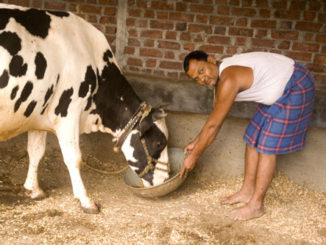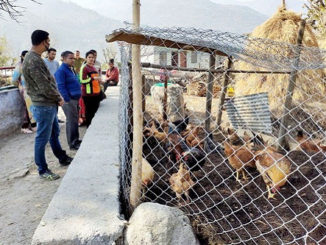Animal husbandry is a branch of agriculture concerned with the care and management of livestock which deals with the feeding, breeding, housing and health care of livestock for getting maximum benefits. Livestock refers to farm animals (domesticated animals such as cow, buffalo, horse, sheep, goat, pig, poultry etc) kept by humans for a useful commercial and domestic purpose. The word “Animal” in animal husbandry means only those domesticated animals which are reared mostly for economic or for recreation purposes, such as cattle, buffalo, sheep, goat, camel, pig, horse, etc. It also includes poultry farming and fisheries and word ‘Husbandry’ means the management of domestic affair. The term used in connection with animal husbandry includes proper feeding, breeding, health care, housing, etc. Animal husbandry includes day-to-day care, selective breeding and the raising of livestock. Husbandry has a long history, starting with the Neolithic revolution and was driven by the need to have food.
In India, the livelihood of two-third of the rural community depends on animal husbandry. The livestock sector contributes 4.11% GDP and 25.6% of total Agriculture GDP. It also provides employment to 8.8% of the Indian population. Therefore, supporting the agriculture sector as well as the Indian economy. The total value of the output of the agricultural sector increased from 28.2 percent to 30.1 percent during 2004-05 to 2012-13 only. (Source: 20th Livestock Census)
Traditionally, animal husbandry was part of the subsistence farmer’s way of life, producing not only the food needed by the family but also the fuel, fertilizer, clothing, transport and draught power. Killing the animal for food was a secondary consideration, and wherever possible its products, such as wool, eggs, milk and blood (by the Maasai) were harvested while the animal was still alive.
Integrating animal husbandry into crop producing farms is one of the principles of organic farming. In temperate and arid zones, animal husbandry plays an important role in the recycling of nutrients, while it is less emphasized in the humid tropics. The caring, training, and nurturing of animals is considered an art in many farming communities.
Many farm animals have a multi-functional role, for example, animals:
- Produce dung, which is of great importance for soil fertility;
- Yield products such as milk or eggs for sale or own consumption continuously;
- Recycle by-products such as straw or kitchen waste;
- Serve as draught animals for tillage or transport;
- Produce meat, hides, feathers, horns, etc.; serve as an investment or a bank
- Help in pest control (e.g. dugs);
- Help in weed management (e.g. grazing on barren fields);
- Have cultural or religious significance (prestige, ceremonies, etc.); and
- Produce young stock for breeding or sale.
Animal rearing is important for humans as they attain a wide range of food products having high nutrient values. The demand for crops grown organically has increased many times in recent years. These crops have higher available nutrients and lesser toxic chemicals. It also ensures the good quality chemical-free feed or fodder availability to the animals which in turn increases the quality of product. It provides nutritional security to the farmers through nutritious milk and high-quality animal protein which is essential for balance growth and maintenance of good health of his family members. Animal husbandry takes care of management and breeding of animals and is a large scale business. A farm or a specific region is built for providing shelter, food and undertaking culturing processes. It also involves apiculture i.e. bee agriculture and aquaculture i.e. marine culture.
Dairy products producing animals are major source of milk and milk products, meats and meat products, eggs, wool and leather. Livestock is used to control the growth of weeds on agricultural lands as the dry shrubs that are prone to fir are eaten up by various animals. This reduces the risk and harm that can be faced with unprecedented situations. So, it is important for land management. The importance of animal husbandry also lies in the fact that excreta, bones, and blood of animals can be used as manure or fertilizer via composting. These can be spread on fields to enhance crop yield. Animals are helpful for ploughing fields, military functions and transporting goods from one place to another.
Types of Animal Husbandry
Major types of animal husbandry practiced in the world today:
Dairy Farming
Dairy farming is the agricultural technique concerned with the long term production of milk, which is then processed to obtain dairy products such as curd, cheese, yoghurt, butter, cream, etc. It involves the management of dairy animals such as cows, buffaloes, sheep, goat, etc.
Poultry Farming
Poultry farming is concerned with raising and breeding of birds for commercial purposes. Birds like ducks, chickens, geese, pigeons, turkeys, etc. are domesticated for eggs and meat.
Land Management
The livestock is sometimes grazed to control the growth of weeds on agricultural land. The dry shrubs in the areas that are prone to wildfire are eaten by goat and sheep, which reduces the risk of fire.
Fibre
Animals also produce fibers or textiles such as wool and leather. For e.g., sheep are reared for wool where as leather can be obtained from camel.
Manure
The excreta, blood and bones of animals are used as manure. The manure is spread on the fields to increase the crop yields and crop production. It is also used as fuel for fires and as plaster for walls and floor.
Labour
Animals are a source of non-human labor. They are used for ploughing fields, transporting goods and military functions. Fore. g., horses, yaks and donkeys are used for such purposes.
Animal husbandry has the following advantages:
- Animal husbandry helps in the proper management of animals by providing proper food, shelter and protection against diseases to domestic animals.
- It provides employment to a large number of farmers and thereby increases their living standards.
- It helps in developing high yielding breeds of animals by cross breeding. This increases the production of various food products such as milk, eggs, meat, etc.
- It involves the proper disposal of animal waste and promotes a healthy environment.
Effect of Animal Husbandry on Environment
Animal husbandry has a significant impact on the world environment. It is responsible for somewhere between 20 and 33% of the fresh water usage in the world, and livestock, and the production of feed for them, occupy about a third of the earth’s ice-free land. Livestock production is a contributing factor in species extinction, desertification, and habitat destruction. Animal agriculture contributes to species extinction in various ways. Habitat is destroyed by clearing forests and converting land to grow feed crops and for animal grazing, while predators and herbivores are frequently targeted and hunted because of a perceived threat to livestock profits; for example, animal husbandry is responsible for up to 91% of the deforestation in the Amazon region. In addition, livestock produce greenhouse gases. Cows produce some 570 million cubic meters of methane per day that accounts for from 35 to 40% of the overall methane emissions of the planet. Livestock is responsible for 65% of all human-related emissions of the powerful and long-lived greenhouse gas nitrous oxide.
In the end, it can be clearly seen that animal husbandry plays the biggest role in agriculture. Every farm practice or agricultural practice is connected with livestock through many interwoven ways. Agricultural sector can be strengthened by strengthening the livestock sector and vice versa. The fate and progress of any nation depends on agriculture which itself depends on animals/livestock assets flourishing there.








Be the first to comment